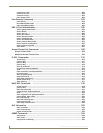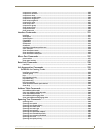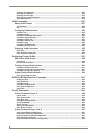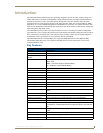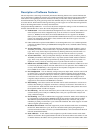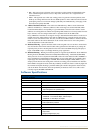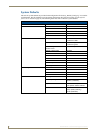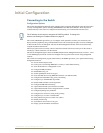
Introduction
4
NXA-ENET24 - Software Management Guide
RIP – This protocol uses a distance-vector approach to routing. Routes are determined on the
basis of minimizing the distance vector, or hop count, which serves as a rough estimate of
transmission cost.
OSPF – This approach uses a link state routing protocol to generate a shortest-path tree, then
builds up its routing table based on this tree. OSPF produces a more stable network because the
participating routers act on network changes predictably and simultaneously, converging on the
best route more quickly than RIP.
Address Resolution Protocol – The switch uses ARP and Proxy ARP to convert between IP
addresses and MAC (i.e., hardware) addresses. This switch supports conventional ARP, which
locates the MAC address corresponding to a given IP address. This allows the switch to use IP
addresses for routing decisions and the corresponding MAC addresses to forward packets from one
hop to the next. You can configure either static or dynamic entries in the ARP cache.
Proxy ARP allows hosts that do not support routing to determine the MAC address of a device on
another network or subnet. When a host sends an ARP request for a remote network, the switch
checks to see if it has the best route. If it does, it sends its own MAC address to the host. The host
then sends traffic for the remote destination via the switch, which uses its own routing table to
reach the destination on the other network.
Multicast Filtering – Specific multicast traffic can be assigned to its own VLAN to ensure that it
does not interfere with normal network traffic and to guarantee real-time delivery by setting the
required priority level for the designated VLAN. The switch uses IGMP Snooping and Query at
Layer 2 and IGMP at Layer 3 to manage multicast group registration.
Multicast Routing – Routing for multicast packets is supported by the Distance Vector Multicast
Routing Protocol (DVMRP) and Protocol-Independent Multicasting - Dense Mode (PIM-DM).
These protocols work in conjunction with IGMP to filter and route multicast traffic. DVMRP is a
more comprehensive implementation that maintains its own routing table, but is gradually being
replacing by most network managers with PIM, Dense Mode and Sparse Mode. PIM is a very
simple protocol that uses the routing table of the unicast routing protocol enabled on an interface.
Dense Mode is designed for areas where the probability of multicast clients is relatively high, and
the overhead of frequent flooding is justified. While Sparse mode is designed for network areas,
such as the Wide Area Network, where the probability of multicast clients is low. This switch
currently supports DVMRP and PIM-DM.
Software Specifications
Software Specifications
Software Features
Authentication: Local, RADIUS, TACACS, Port (802.1x), HTTPS, SSH, Port Security
Access Control Lists: IP, MAC (up to 32 lists)
POE: Power Over Ethernet
SNMPv3: • Management access via MIB database
• Trap management to specified hosts
DHCP: Client, Relay
Port Configuration: • 100BASE-TX: 10/100 Mbps, half/full duplex
• 1000BASE-T: 10/100/1000 Mbps, half/full duplex
• 1000BASE-X: 1000 Mbps, full duplex
Flow Control: • Full Duplex: IEEE 802.3x
• Half Duplex: Back pressure
Broadcast Storm Control: Traffic throttled above a critical threshold
Port Mirroring: Multiple source ports, one destination port
Rate Limits: • Input limit
• Output limit
• Range (configured per port)



